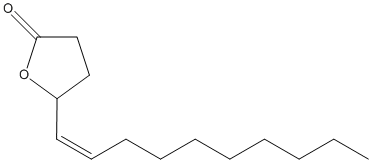Japonilure
General
Type : Odorant || Pheromone || Lactone
Chemical_Nomenclature : (5R)-5-[(Z)-dec-1-enyl]oxolan-2-one
Canonical SMILES : CCCCCCCCC=CC1CCC(=O)O1
InChI : InChI=1S\/C14H24O2\/c1-2-3-4-5-6-7-8-9-10-13-11-12-14(15)16-13\/h9-10,13H,2-8,11-12H2,1H3\/b10-9-\/t13-\/m0\/s1
InChIKey : QTGIYXFCSKXKMO-XPSMFNQNSA-N
Other name(s) : Nuranone, Bag-A-Bug, (R,Z)-5-(1-Decenyl)dihydrofuran-2(3H)-one, Caswell No. 275AA, SCHEMBL142178, ZINC43068431
MW : 224.34
Formula : C14H24O2
CAS_number :
PubChem :
UniChem :
Iuphar :

Target
Families : Carb_B_Arthropoda
References (5)
| Title : Mass trapping Popillia quadriguttata using Popillia japonica (Coleoptera: Scarabaeidae) pheromone and floral lures in northeastern China - Chen_2014_Environ.Entomol_43_774 |
| Author(s) : Chen RZ , Klein MG , Li QY , Li Y |
| Ref : Environ Entomol , 43 :774 , 2014 |
| Abstract : Chen_2014_Environ.Entomol_43_774 |
| ESTHER : Chen_2014_Environ.Entomol_43_774 |
| PubMedSearch : Chen_2014_Environ.Entomol_43_774 |
| PubMedID: 24780142 |
| Title : Chiral discrimination of the Japanese beetle sex pheromone and a behavioral antagonist by a pheromone-degrading enzyme - Ishida_2008_Proc.Natl.Acad.Sci.U.S.A_105_9076 |
| Author(s) : Ishida Y , Leal WS |
| Ref : Proc Natl Acad Sci U S A , 105 :9076 , 2008 |
| Abstract : Ishida_2008_Proc.Natl.Acad.Sci.U.S.A_105_9076 |
| ESTHER : Ishida_2008_Proc.Natl.Acad.Sci.U.S.A_105_9076 |
| PubMedSearch : Ishida_2008_Proc.Natl.Acad.Sci.U.S.A_105_9076 |
| PubMedID: 18579770 |
| Gene_locus related to this paper: popja-q2til3 |
| Title : Biosynthesis of scarab beetle pheromones - Leal_1999_Eur.J.Biochem_259_175 |
| Author(s) : Leal WS , Zarbin PH , Wojtasek H , Ferreira JT |
| Ref : European Journal of Biochemistry , 259 :175 , 1999 |
| Abstract : Leal_1999_Eur.J.Biochem_259_175 |
| ESTHER : Leal_1999_Eur.J.Biochem_259_175 |
| PubMedSearch : Leal_1999_Eur.J.Biochem_259_175 |
| PubMedID: 9914490 |
| Title : The scarab beetleAnomala albopilosa sakishimana utilizes the same sex pheromone blend as a closely related and geographically isolated species,Anomala cuprea - Leal_1994_J.Chem.Ecol_20_1667 |
| Author(s) : Leal WS , Kawamura F , Ono M |
| Ref : J Chem Ecol , 20 :1667 , 1994 |
| Abstract : Leal_1994_J.Chem.Ecol_20_1667 |
| ESTHER : Leal_1994_J.Chem.Ecol_20_1667 |
| PubMedSearch : Leal_1994_J.Chem.Ecol_20_1667 |
| PubMedID: 24242659 |
| Title : Identification and field evaluation ofAnomala octiescostata (Coleoptera: Scarabaeidae) sex pheromone - Leal_1994_J.Chem.Ecol_20_1643 |
| Author(s) : Leal WS , Hasegawa M , Sawada M , Ono M , Ueda Y |
| Ref : J Chem Ecol , 20 :1643 , 1994 |
| Abstract : Leal_1994_J.Chem.Ecol_20_1643 |
| ESTHER : Leal_1994_J.Chem.Ecol_20_1643 |
| PubMedSearch : Leal_1994_J.Chem.Ecol_20_1643 |
| PubMedID: 24242657 |